Works
Experience
We have worked with a wide variety of institutions abroad, including the Grand Egyptian Museum, East London University, Xi’an Jiaotong University, University of New South Wales, City University of Hong Kong, Republic of Korea National University, SunM Color Co., Ltd., and others.
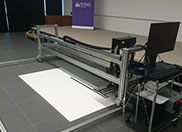
International Research Institute of Disaster Science ( 2018 )
Delivery of LIAM-S scanner.

Benrido Co., Ltd. ( 2016 )
Delivery of glass dry plate scanner.
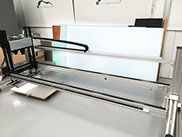
Kyushu National Museum ( 2013- )
Delivery of high-definition scanners “Niji-H”, “Niji-S”. Full-spectrum high resolution scans, IR and multi-band scans for pigment content analysis.
Results
Based on advanced scanning and analysis technologies, we have scanned temple treasures, artwork and cultural assets, both in Japan and abroad, in high-definition digitization of 8000 dpi and higher.
We scanned national treasure “Shingon Shichiso-zou”.
Shokoku-ji Jotenkaku Museum(2018)
We scanned “Syaka Sanzon-zu” painted by Jyakuchu Ito.
Kyoto National Museum (2018)
We scanned national treasure “Kujyaku Myo-ou-zu”, using ultra-high resolution simultaneously near-infrared scanned.
Diplomatic Archives of the Ministry of Foreign Affairs of Japan(2018)
We digitized about 1000 items, historical materials in the from mid- 1800s to late 1980s.
Nagoya Castle (2018)
We scanned fusuma paintings, and important cultural property (government-designated) “Chikurin Hyokozu”.
Amanosan Kongoji (2018)
We scanned national treasure “Jitsugetsusansui-zu Byobu”, using ultra-high resolution simultaneously near-infrared scanned.
Kyoto Imperial Palace (2018)
We scanned Seiryoden mural.
National Archives of Japan (2018)
We scanned old maps (maximum 4m) in the Edo-period about 59 items.
Chion-in (2017)
We scanned fusuma paintings and mural paintings about 115 objects, and design of a new standing scanner for a mural painting (6 x 3 m).
Kyoto University Library (2017)
We scanned the drawings of architectures by Josiah Conder (about 350 objects), and Nakai Collection (68 old maps and about 100 items regarding Nijo Castle) .
Panasonic Shiodome Museum (2016)
We captured in a variety of ways by controlling light and taking a number of pictures of the objects in the works.
Bridgestone Museum of Art (2016)
We scanned a large number of works are using different methods, including near-infrared.
Iran National Carpets Museum (2016)
We scanned 16 images in carpets, including the Sangeshko carpet (3 x 6 m).
Nezu Institute of Fine Arts (2015)
Using ultra-high resolution photography of 1200 dpi and greater, and near-infrared imaging, we scanned several objects in a Buddhist paintings from Goryeo era (Korean dynasty, 918-1392), including those designated as Important Cultural Properties.

Roerich Museum (2015)
We successfully digitized all objects within the museum’s paintings (about 250 objects). The process lasted about three weeks, during which time we also designed a vertical scanner to obtain images within artwork that was still displayed on walls.
Museum of Fine Arts (MFA), Boston (2015)
We performed a special shoot of a painting on the back of a sarcophagus. In addition, we created ultra-high resolution scans of Gauguin prints. Until now, no one had been able to photograph or observe the back of the sarcophagus. We worked in cooperation with an academic researcher to ensure that the scans were flawless.
Philadelphia Museum of Art (2014)
We successfully scanned ten images within a chiaroscuro woodblock print, as well as a several objects in other oil paintings. Until now, this material had not been researched but, but our high-resolution scans have allowed academic scholars to start researching this artwork.
Sennyū-ji temple (2014)
Images of a large scroll (2 m x 1.5 m x 3 m x 3 m) were taken with resolutions exceeding 1200 dpi.
Hong Kong Maritime Museum (2013)
For this project, we brought in the NIJI scanner to digitize the “Pirate Picture Scroll,” a National Treasure housed in the Hong Kong Maritime Museum. As part of the renovation and re-opening of the museum, this 33 metre scroll story was scanned in 1200 dpi resolution. Subsequently, we also were able to display it on a 360 degree screen.
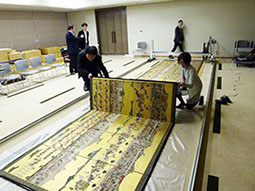 Sen-oku Hakuko Kan (ongoing from May 2012)
Sen-oku Hakuko Kan (ongoing from May 2012)
Some of the objects, such as gold folding screens or large scrolls, are difficult to capture with conventional digital photography. In this project, we are digitizing them with our scanner.
Northern Ireland National Museum (2012)
Around 50 objects within 130 drawings of the Titanic were captured with ultra-high resolution scanning at a maximum dpi of 5000. Academic scholars were then able to proceed with research.
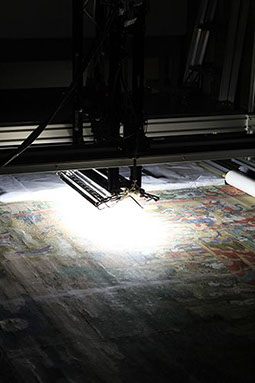
Nagoya Castle (2012)
Imaging took place over a series of 3 days, and around 300 valuable rubbings were digitized.
Okinawa Prefecture Archives (2011)
We digitized 1,000 B0-size prewar acreage drawings. Since many of the drawings were incredibly detailed, we captured them in high resolution exceeding 600 dpi to enable uncompromised viewing experience.
Omuronin’naji, Head temple of the Shingon Omuro sect (2011)
We designed a scanner capable of capturing large-scale vertical objects, and then performed imaging on wide variety of objects, including sliding door paintings, panel drawings/paintings, folding screens, hanging scrolls, temple murals, and statues (including statues of gold).
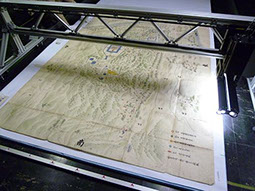
Kyoto Prefectural Library and Archives (2011)
→ Toji Hyakugo-monjyo WEB
We digitized around 150 objects of around 800 documents, including National Treasures and Important Cultural Properties. Included among these were large-scale drawings exceeding 3 m x 20 cm that have been on display for over 20 years. After completing scanning in half a day, digitized materials were then made available via viewing software, Web browsing and printing within the Archives, making thematerials more accessible than they have ever been.
Kyoto University Museum: Odoi illustration (2009)
Using the digital cultural heritage browsing system at the museum, a digital exhibition was held that also incorporated existing technologies such as touch panels.
Digitization and construction of database of Josiah Conder’s drawings (2008)
We scanned 468 design drawings on 28 themes by Josiah Conder in collections owned by Kyoto University and Mitsubishi Sekkei. These documents had been designated Important Cultural Properties in 2008. We also created a database for the digital data and performed digital restoration, and created duplicate prints to exhibit.

